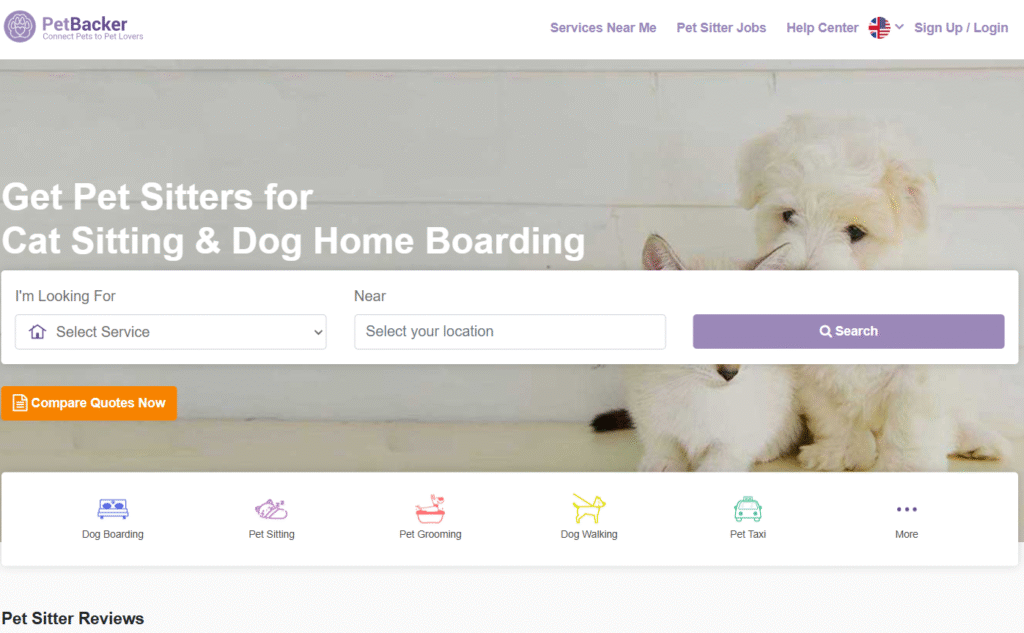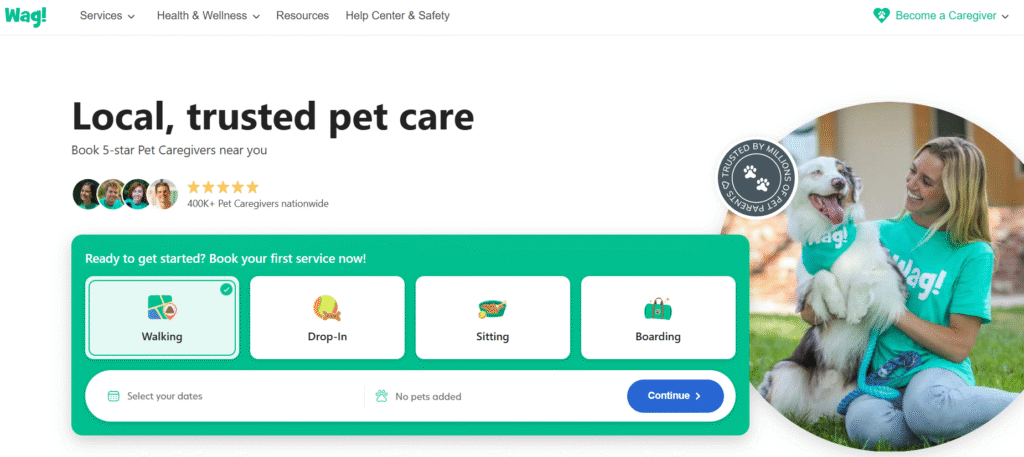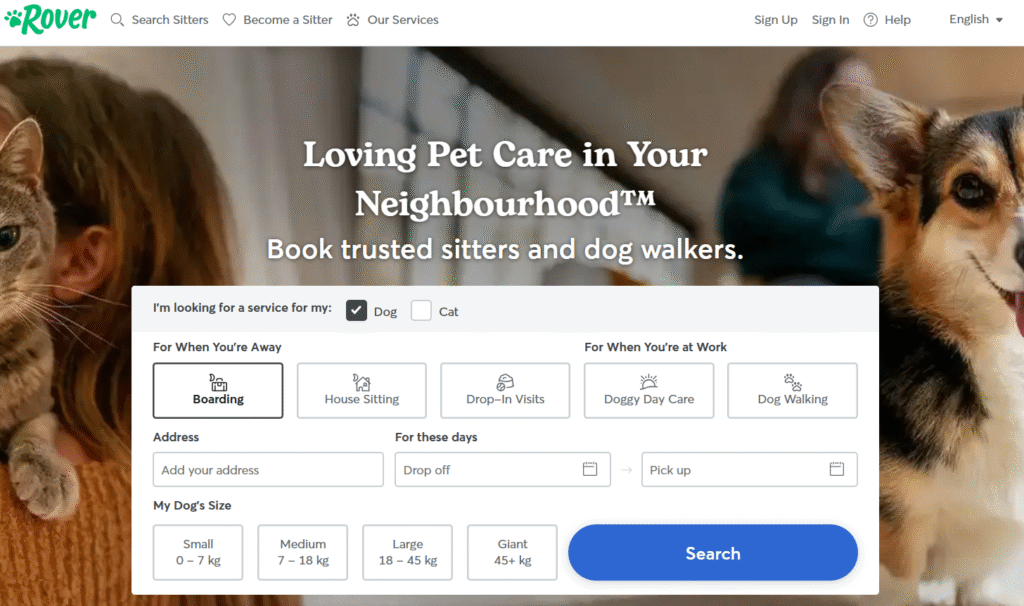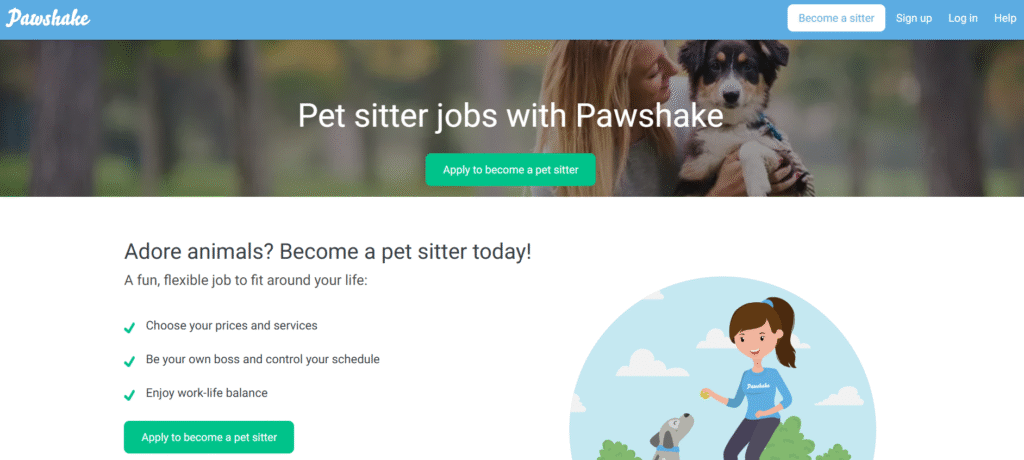Dog Walking Jobs: 12 Ways To Get Paid To Walk Dogs

Who says making money has to be complicated? If you love dogs and need some extra cash, I’ve got news for you: there’s a whole world of opportunities just waiting for you to leash up and get started.
Trust me, after diving deep into the dog walking industry (and speaking from my own experience as someone who’s analyzed countless side hustles), this gig can be way more profitable than most people realize.
Think about it: you’re getting paid to exercise, spend time with adorable pups, and enjoy fresh air. Sounds pretty sweet, right?
But here’s the kicker: while some folks treat this as pocket change work, others are pulling in serious income. We’re talking about people making $3,000+ monthly just from walking dogs. Not too shabby for a “simple” side hustle!
What Is A Dog Walker?
Let’s get this straight from the get-go. A dog walker isn’t just someone who shows up, clips on a leash, and wanders around the block. You’re essentially becoming a temporary guardian for someone’s beloved family member.
Dog owners hire walkers when life gets in the way of their pet care routine. Maybe they’re stuck in back-to-back meetings, working overtime, or dealing with a family emergency. That’s where you come in as their lifesaver.
The beauty of this gig? It’s flexible enough to fit around your existing schedule, yet structured enough to provide consistent income. Whether you’re a college student, stay-at-home parent, or someone looking to supplement their 9-to-5 income, dog walking can work for you.
What Does A Dog Walker Do?
Here’s where things get interesting. Your responsibilities go way beyond just putting one paw in front of the other. You’re essentially running a mini pet care operation, and smart walkers understand this from day one.
Your core responsibilities include:
- Route planning, you’ll scout safe, engaging paths that match each dog’s energy level and needs
- Health monitoring, keeping an eye out for limping, excessive panting, or any unusual behavior
- Safety management, avoiding aggressive dogs, busy roads, and potential hazards
- Basic training reinforcement, maintaining the good habits their owners have worked hard to establish
- Communication, updating owners with photos, messages, or reports about their pet’s walk
Some clients might throw you curveballs, too. Maybe Fluffy needs medication during the walk, or Max has specific behavioral triggers you need to avoid. The more professional you are about handling these details, the more you’ll earn. It’s that simple.
How Much Do Dog Walkers Make?
Let’s talk numbers because I know that’s what you’re really here for 🙂
The average dog walker pulls in around $2,962 monthly, but here’s where my finance background kicks in: averages can be misleading. Your actual earnings depend on several key factors that most people overlook.
Factors affecting your income:
- Location matters big time. Urban areas typically pay $15-25 per walk, while suburban areas might offer $10-18
- Service frequency, Regular clients who book 3-5 walks weekly are your goldmine
- Premium services, offering add-ons like feeding, playtime, or basic grooming, can double your per-visit rate
- Client quality, Affluent neighborhoods often pay premium rates and tip generously
From a financial planning perspective, I’ve seen successful dog walkers structure their business to generate $40,000-60,000 annually. The secret? They treat it like a real business, not just a casual side gig.
How To Become A Dog Walker
Getting started isn’t rocket science, but there’s definitely a right way and a wrong way to approach this. Most people make the mistake of thinking they can just wing it, but successful dog walkers understand the importance of building credibility from day one.
Here’s your roadmap:
Step 1: Build your foundation. Start by getting comfortable with different dog breeds, sizes, and temperaments. If you don’t own a dog, volunteer at local shelters or offer to walk dogs for friends and family. This isn’t just about gaining experience; you’re building your confidence and reputation.
Step 2: Get certified (seriously, do this). While not always required, pet first aid certification sets you apart from casual walkers. Companies like Pet Tech and PetSaver offer courses that cost around $50-100. Think of it as an investment that pays for itself after just a few premium clients.
Step 3: Create your professional image. This means having a clean background check, reliable transportation, and basic business insurance. Sounds overkill? Trust me, professional clients pay professional rates.
Step 4: Choose your path. You can either work with established apps/companies (easier to start, but lower margins) or build your own client base (harder initially, but much more profitable long-term).
12 Best Dog Walking Apps & Websites To Make Money
Alright, here’s the meat and potatoes of this whole operation. I’ve analyzed these platforms from both a user experience and financial opportunity perspective. Some are absolute goldmines, while others… well, let’s just say you might want to keep your day job.
1. PetBacker

PetBacker is like the international heavyweight champion of dog walking platforms. Operating in over 50 countries, this isn’t some small-time operation; they’re the real deal.
What I love about PetBacker is their badge system. It’s basically their way of rewarding top performers, and those badges translate directly into more bookings. More bookings = more money. Simple math, right?
The financial breakdown:
- They start with a 25% commission (ouch, I know)
- But here’s the kicker: this drops to 15% as you build experience
- Top walkers report earning $800-1,500 monthly on the platform
Pro tip: Focus on building those badges early. The initial commission sting is worth it for the long-term earning potential.
2. Steady
Steady takes a different approach that I really appreciate. Instead of just being another dog walking app, they’re focused on helping Americans stabilize their income, hence the name.
What sets Steady apart is their financial support system. They offer grants, bonuses, and financial resources alongside job listings. As someone who’s spent years in finance, I can tell you that having multiple income streams and financial support is crucial for building wealth.
The platform connects you with various gig opportunities, including dog walking, which means you’re not putting all your eggs in one basket. Smart move for anyone serious about their financial future.
3. Fetch
Fetch has been around since 2002, which in the gig economy world makes them practically ancient. But here’s why that’s actually awesome: they’ve had over two decades to perfect their system.
The catch? Getting hired isn’t a walk in the park (pun intended). They operate through local franchise owners, which means:
- You’ll face a thorough application process
- Background checks are mandatory
- You’ll need to interview with local franchise owners
- The screening process can take several weeks
But here’s why it’s worth it: Fetch clients tend to be higher-income households who value professionalism and pay accordingly. If you can get through their hiring process, you’re looking at some of the most stable, well-paying dog walking gigs available.
4. Wag

Everyone calls Wag the “Uber of dog walking,” and honestly, the comparison fits. Available in over 8,000 cities across all 50 states, finding clients won’t be your problem here.
The good:
- A massive user base means consistent booking opportunities
- You control your schedule completely
- Weekly payments through their Payable app
- Strong brand recognition helps with client trust
The not-so-good:
- That 40% commission rate makes me wince every time
- High competition means you need to hustle for the best time slots
From a financial perspective, Wag works best as a supplementary income source rather than your primary dog walking platform. Use it to fill gaps in your schedule, but don’t rely on it as your main revenue stream.
5. Rover

If I had to pick one platform to recommend to someone just starting, Rover would be it. With over 1 million pet owners using their service, you’re tapping into a massive market.
What makes Rover special:
- You set your own rates (finally, some pricing control!)
- Fast payment processing, money hits your account 2 days after completing services.
- Comprehensive insurance coverage included
- A strong review system helps build your reputation
The investment: That $25 background check fee might seem steep upfront, but think of it this way, it’s less than what you’ll make from your first few walks. Plus, having a clean background check from a reputable company like Rover opens doors with other platforms, too.
6. Care.com
Care.com isn’t just about dogs; they’re a full-service care platform with over 35 million members. This diversity actually works in your favor because it means consistent traffic and varied opportunities.
The membership model: Starting at $13 monthly, this isn’t free to join. But here’s my take as someone who’s analyzed countless subscription models: this fee actually filters out casual walkers, meaning less competition for you.
Financial benefits of the membership:
- Enhanced profile visibility
- Access to premium client listings
- Priority booking opportunities
- Better customer support
If you’re serious about dog walking (not just testing the waters), that monthly fee pays for itself pretty quickly.
7. Holidog
Holidog brings an international flavor to the dog walking scene, operating in the US, Europe, Australia, and Brazil. What caught my attention immediately? No background checks required.
The zero-fee structure is brilliant:
- No commissions taken from walkers
- No membership fees
- No hidden costs
Instead, they charge pet owners for platform access. It’s a refreshing change from the usual commission-heavy models. Less bureaucracy, more money in your pocket, exactly how business should work.
8. Pawshake

Pawshake operates mainly in Europe and Asia, but its model is worth understanding. They only accept 15% of applicants, making this the Harvard of dog walking platforms.
Why the exclusivity works:
- Less competition once you’re accepted
- Higher-quality clients who value premium service
- Strong insurance coverage (they’ve got your back if something goes wrong)
- 19% commission rate (reasonable considering the perks)
If you’re in their service area and can handle their rigorous vetting process, Pawshake offers some of the most professional, well-compensated dog walking opportunities available.
9. Barkly Pets
Barkly Pets caught my attention with their refreshingly honest fee structure. No commission fees? In this industry? That’s practically unheard of!
Their pricing model:
- $10 one-time setup fee
- $8.50 monthly membership once you hit $100 in earnings
- Zero commission on your bookings
The safety focus: Since 2015, they’ve positioned themselves as America’s safest dog walking company. They even offer discounted pet first aid and CPR certification courses. Smart business move that benefits everyone involved.
10. Paway
Paway takes a comprehensive approach that I really respect. They don’t just connect you with clients, they provide the tools and resources to help you succeed.
What sets them apart:
- Detailed safety information and hazard awareness training
- Resource mapping (finding poop bag dispensers, water sources, etc.)
- Community support and networking opportunities
- Focus on local market development
This platform understands that successful dog walkers need more than just bookings; they need education and support systems.
11. Swifto
Swifto operates exclusively in New York City and Miami, which immediately tells you something about their client base. They’re targeting high-density, affluent urban markets where pet owners will pay premium rates for quality service.
The commitment level: Minimum 15 walks weekly means this isn’t for casual walkers. But experienced walkers handle up to 40 walks weekly, which translates to substantial income in these high-cost markets.
Financial perspective: Limited geographic scope means intense competition to get hired, but once you’re in, you’re accessing some of the highest-paying dog walking opportunities in the country.
12. NYC Pooch
NYC Pooch represents the premium tier of dog walking services. They’re New York City’s most respected dog walking company, and their standards reflect that reputation.
Why they’re selective: They primarily hire experienced walkers, which might seem discouraging if you’re new. But here’s the thing: experienced walkers on their platform make up to $76,000 annually. That’s not side hustle money; that’s serious income.
Getting noticed: If you’re determined to work with NYC Pooch, build your experience elsewhere first. Come to them with a portfolio of satisfied clients and proven reliability.
How To Start Your Dog Walking Business
Sometimes working for someone else gets old, you know? If you’re ready to build something of your own, starting a dog walking business can be incredibly rewarding both financially and personally. Here’s how to do it right.
Create A Business Name
Your business name is your first impression, so don’t rush this decision. I’ve seen too many entrepreneurs pick generic names that get lost in the crowd.
Naming strategies that work:
- Keep it memorable and easy to pronounce
- Make it playful but professional
- Consider broader pet services (not just dog walking) for future expansion
- Test it out, say it out loud, put it on a business card, see how it feels
Examples of effective naming patterns:
- Action-based: “Happy Tails Walking Service”
- Location-specific: “Downtown Dog Adventures”
- Personality-driven: “Faithful Paws Pet Care”
Avoid anything too cute or complicated. Your name should work just as well on a professional website as it does on a business card.
Understand The Market
Market research sounds boring, but it’s absolutely crucial for your financial success. I can’t stress this enough: understanding your local market determines whether you’ll thrive or just survive.
Key research areas:
Competition analysis:
- How many dog walkers operate in your area?
- What services do they offer?
- What are their pricing strategies?
- Where are the gaps you can fill?
Target market identification:
- Which neighborhoods have the highest concentration of dog owners?
- What’s the typical household income in these areas?
- Are there specific dog breeds that dominate your market?
- What times of day have the highest demand?
Financial opportunity assessment:
- Calculate potential monthly earnings based on local rates
- Factor in seasonal variations (yes, dog walking can be seasonal)
- Identify opportunities for service expansion
Spend a week observing your local parks at different times. Chat with dog owners. You’ll learn more from these conversations than any online research could provide.
Structure Your Pricing
Pricing strategy can make or break your business. The price is too high, and you’ll struggle to get clients. Price too low, and you’ll work yourself to death without building wealth.
Smart pricing approaches:
Competitive pricing research:
- Survey local competitors (both individual walkers and companies)
- Understand what premium services command higher rates
- Identify pricing gaps in your market
Value-based pricing structure:
- Basic walk: 30 minutes for $15-20
- Extended walk: 60 minutes for $25-35
- Premium service: Includes feeding, playtime, and basic grooming for $35-50
- Emergency/last-minute bookings: 25-50% premium
Financial tip: Start slightly below market rate to build your client base, then gradually increase prices as you establish relationships and add value-added services. Your goal should be to raise rates by 10-15% every six months during your first two years.
Promote Yourself
Marketing doesn’t have to be expensive or complicated, but it does need to be consistent. I’ve seen brilliant dog walkers fail because they thought their service quality alone would bring clients. Spoiler alert: it doesn’t work that way.
Digital marketing essentials:
Social media presence:
- Instagram for showcasing happy dogs and customer testimonials
- Facebook for community engagement and local group networking
- Nextdoor for neighborhood-specific marketing
Local marketing tactics:
- Business cards at veterinary offices, pet stores, and grooming salons
- Flyers in dog-friendly apartment complexes
- Networking at local dog parks (best ROI marketing you can do)
- Partnerships with pet-related businesses
Professional credibility builders:
- Simple website with contact information and service details
- Google My Business listing for local search visibility
- Client testimonials and photos (with permission)
- Professional liability insurance certificate
The key is consistency. Spend 30 minutes daily on marketing activities, and you’ll see steady growth in your client base.
Obtain Dog Walking Insurance
This is where most people’s eyes glaze over, but stick with me because this could save your financial future. One incident without proper insurance can wipe out months of earnings and potentially put you in serious debt.
Essential coverage types:
General liability insurance:
- Covers injuries to people or property damage
- Typical cost: $200-400 annually
- Protects your personal assets if something goes wrong
Professional liability insurance:
- Covers claims related to your professional services
- Protects against accusations of neglect or poor care
- Often bundled with general liability
Bonding insurance:
- Protects clients against theft or dishonesty claims
- Shows professionalism and builds trust
- Required by many premium clients
Where to get coverage:
- Pet Sitters Associates offers comprehensive packages starting around $200 annually
- Business Insurance Quote provides comparative quotes
- Many business insurance providers now offer pet care policies
IMO, spending $300-500 annually on proper insurance is one of the smartest financial decisions you can make in this business. It’s tax-deductible, builds client confidence, and protects your assets.
Advanced Strategies For Maximizing Income

Now that we’ve covered the basics, let’s talk about how to really scale your dog walking income. These strategies separate the casual walkers from the serious entrepreneurs.
Building Premium Service Packages
Smart dog walkers don’t just walk dogs; they provide comprehensive pet care solutions. Here’s how to structure premium offerings:
Basic Package: 30-minute walk, fresh water, quick text update ($15-20)
Premium Package: 45-60 minute walk, feeding if needed, playtime, photo updates, basic health check ($30-40)
VIP Package: Everything above plus light grooming, training reinforcement, and emergency availability ($50-65)
The math is beautiful here. If you’re walking the same dog anyway, adding 15 minutes of extra service can increase your rate by 50-75%. That’s leveraging your time efficiently.
Geographic Targeting Strategy
Not all neighborhoods are created equal. Focus your marketing efforts on areas with:
- High household incomes ($75,000+)
- High dog ownership rates
- Busy professional demographics
- Limited yard space (apartment complexes, condos)
Financial insight: One client in an affluent neighborhood paying $35 per walk is worth three clients in average neighborhoods paying $12 per walk. Your time is finite; invest it wisely.
Seasonal Income Optimization
Dog walking demand fluctuates throughout the year, and smart walkers plan for this:
Peak seasons:
- Summer months (families traveling, kids home from school)
- Holiday periods (Thanksgiving through New Year’s)
- Back-to-school season (schedule changes)
Slower periods:
- Late winter/early spring
- Post-holiday months
During peak seasons, you can command premium rates and build your client base. During slower periods, focus on retention, training, and business development.
Common Mistakes That Kill Your Earning Potential
I’ve watched too many promising dog walkers sabotage their own success with preventable mistakes. Learn from their errors instead of making them yourself.
Undervaluing Your Services
The biggest mistake new walkers make? Competing on price alone. You’re not just walking a dog, you’re providing peace of mind, flexibility, and professional pet care. Price accordingly.
Inconsistent Communication
Clients need updates. Period. A simple photo and text message after each walk takes 30 seconds but dramatically increases client satisfaction and retention rates.
Poor Time Management
Booking walks too close together or in inefficient routes wastes your most valuable resource, time. Plan routes that maximize your hourly earnings, not just your total bookings.
Neglecting Business Development
Successful dog walkers spend 20% of their time on business activities: marketing, client communication, service improvement, and financial planning. Treat this seriously, and you’ll outperform 90% of your competition.
Building Long-Term Financial Success
Here’s where my finance background really comes in handy. Most people think of dog walking as quick cash, but smart operators build sustainable, growing businesses.
Creating Recurring Revenue Streams
Monthly service packages are your best friend. Instead of booking individual walks, sell packages:
- 8 walks per month: $120 (equivalent to $15 per walk)
- 12 walks per month: $168 (equivalent to $14 per walk, but guaranteed income)
- 20 walks per month: $260 (equivalent to $13 per walk, but premium volume pricing)
Clients love the convenience and predictable costs. You love the guaranteed income and easier scheduling.
Scaling Beyond Personal Service
Once you’re earning $3,000+ monthly, consider expansion strategies:
Hiring additional walkers:
- Start with independent contractors for overflow work
- Develop standard operating procedures
- Create quality control systems
- Build management fees into your pricing structure
Service diversification:
- Pet sitting during vacations
- Basic grooming services
- Dog training consultation
- Pet taxi services for vet visits
Technology integration:
- GPS tracking for client peace of mind
- Automated scheduling and payment systems
- Customer relationship management tools
- Financial tracking and reporting systems
Tax Optimization Strategies
FYI, most dog walkers miss out on significant tax deductions. Here are the key ones to track:
- Vehicle expenses (mileage to/from clients)
- Business insurance premiums
- Professional development (training courses, certifications)
- Marketing expenses (business cards, flyers, website costs)
- Equipment purchases (leashes, waste bags, first aid supplies)
- Home office expenses (if you handle scheduling/admin from home)
Pro tip: Use apps like QuickBooks Self-Employed or FreshBooks to track expenses automatically. Come tax time, you’ll thank me for this advice.
Final Thoughts
Look, walking dogs for money isn’t just some cute side hustle anymore. With the right approach, it’s a legitimate path to financial independence. Whether you choose to work with established platforms or build your own business, the opportunities are definitely there.
The platforms I’ve outlined each serve different needs and experience levels. Start with one that matches your current situation, build your skills and reputation, then consider expanding to additional platforms or launching your own operation.








